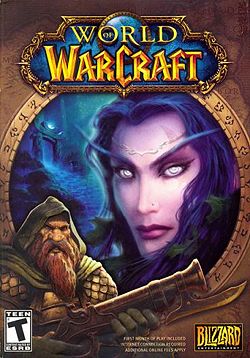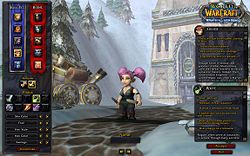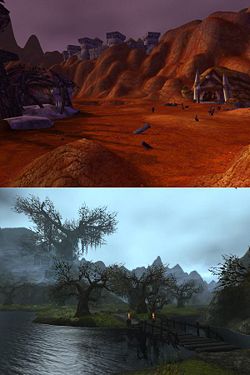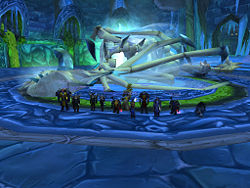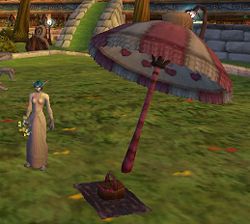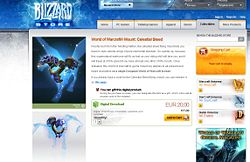World of Warcraft: Difference between revisions
imported>Peter Schmitt m (→Characters: 4 copyedits) |
imported>Jess Key No edit summary |
||
| Line 12: | Line 12: | ||
}} | }} | ||
'''World of Warcraft''' (also commonly abbreviated as '''WoW''') is a [[MMORPG|Massively Multiplayer Online Role-Playing Game ]] (MMORPG) that was released in [[North America]] in 2004 by [[Blizzard Entertainment]].<ref name="wowreleasedate">[http://www.gamershell.com/companies/blizzard_entertainment/185269.html Blizzard Entertainment® Announces World of Warcraft® "Street Date" - November 23, 2004] - Press release from Blizzard Entertainment November 4, 2004</ref> It is the fourth full game released by Blizzard Entertainment in the [[Warcraft|Warcraft series]]. WoW has seen paramount success, having sold over 11 million copies,<ref>[http://us.blizzard.com/en-gb/company/press/pressreleases.html?081223 World of Warcraft® subscriber base reaches 11.5 million worldwide] - Press release from Blizzard Entertainment December 23rd, 2008</ref> and has been a great credit to MMORPG video games, introducing thousands of people to the genre. The game is available to play in several countries, including North America, [[Europe]], [[China]], [[Korea]], [[Australia]], [[New Zealand]], [[Singapore]], [[Taiwan]], [[Hong Kong]], and [[Macau]], and is available in five languages ([[English]], [[Spanish]], [[French]], [[German]], and [[Russian]]). World of Warcraft | '''World of Warcraft''' (also commonly abbreviated as '''WoW''') is a [[MMORPG|Massively Multiplayer Online Role-Playing Game ]] (MMORPG) that was released in [[North America]] in 2004 by [[Blizzard Entertainment]].<ref name="wowreleasedate">[http://www.gamershell.com/companies/blizzard_entertainment/185269.html Blizzard Entertainment® Announces World of Warcraft® "Street Date" - November 23, 2004] - Press release from Blizzard Entertainment November 4, 2004</ref> It is the fourth full game released by Blizzard Entertainment in the [[Warcraft|Warcraft series]]. WoW has seen paramount success, having sold over 11 million copies,<ref>[http://us.blizzard.com/en-gb/company/press/pressreleases.html?081223 World of Warcraft® subscriber base reaches 11.5 million worldwide] - Press release from Blizzard Entertainment December 23rd, 2008</ref> and has been a great credit to MMORPG video games, introducing thousands of people to the genre. The game is available to play in several countries, including North America, [[Europe]], [[China]], [[Korea]], [[Australia]], [[New Zealand]], [[Singapore]], [[Taiwan]], [[Hong Kong]], and [[Macau]], and is available in five languages ([[English]], [[Spanish]], [[French]], [[German]], and [[Russian]]). As of 2010 World of Warcraft holds the [[Guinness World Record]] for Most Popular [[MMORPG]]<ref>[http://gamers.guinnessworldrecords.com/records/pc_gaming.aspx Guinness World Records Gamer's Edition] - PC Gaming Records, retrieved 22 March 2010</ref> | ||
Blizzard has released two expansion packs to the game, each introducing additional content. ''The Burning Crusade'' was released in 2007, and ''The Wrath of the Lich King'' was released in 2008. In August of 2009, Blizzard announced a third expansion, titled ''Cataclysm'', which is expected to be released in late 2010. Each expansion brings new zones to explore and allows characters to progress further in level and ability. | Blizzard has released two expansion packs to the game, each introducing additional content. ''The Burning Crusade'' was released in 2007, and ''The Wrath of the Lich King'' was released in 2008. In August of 2009, Blizzard announced a third expansion, titled ''Cataclysm'', which is expected to be released in late 2010. Each expansion brings new zones to explore and allows characters to progress further in level and ability. | ||
Revision as of 01:54, 8 June 2010
| World of Warcraft | |
|---|---|
| Part of the Warcraft series | |
| Genre(s) | MMORPG |
| Year of Release | 2004 |
| Platform(s) | Mac OS X, Microsoft Windows |
| Developer(s) | Blizzard Entertainment |
| Publisher(s) | Blizzard Entertainment |
| Official Website | www.worldofwarcraft.com |
World of Warcraft (also commonly abbreviated as WoW) is a Massively Multiplayer Online Role-Playing Game (MMORPG) that was released in North America in 2004 by Blizzard Entertainment.[1] It is the fourth full game released by Blizzard Entertainment in the Warcraft series. WoW has seen paramount success, having sold over 11 million copies,[2] and has been a great credit to MMORPG video games, introducing thousands of people to the genre. The game is available to play in several countries, including North America, Europe, China, Korea, Australia, New Zealand, Singapore, Taiwan, Hong Kong, and Macau, and is available in five languages (English, Spanish, French, German, and Russian). As of 2010 World of Warcraft holds the Guinness World Record for Most Popular MMORPG[3]
Blizzard has released two expansion packs to the game, each introducing additional content. The Burning Crusade was released in 2007, and The Wrath of the Lich King was released in 2008. In August of 2009, Blizzard announced a third expansion, titled Cataclysm, which is expected to be released in late 2010. Each expansion brings new zones to explore and allows characters to progress further in level and ability.
Characters
After setting up a World of Warcraft account, players must create a character to use in the game world. This avatar represents the player, a standard in most RPGs. Each character has its own set of traits, and in World of Warcraft most of these character data is stored server-side to avoid hacking attempts on the client side.
The first decision in the character creation process is choosing a faction. Characters in World of Warcraft are split into two factions known as the Alliance and the Horde. Characters from one faction cannot communicate, trade or play with characters from the opposing faction, and in many circumstances players from the two factions directly compete, especially in player-vs-player situations.
Once the player has chosen a faction they must then choose a race. Each faction has five races available to it, with a sixth being added to each faction in the upcoming Cataclysm expansion. Each race has its own unique racial traits and therefore more advanced players may base their decision on these traits. However, these are usually minor advantages and a player will not be significantly disadvantaged because of the race they choose. More information on the races can be found in this catalog.
Once the player has chosen their race they must then choose a class. There are nine normal classes and one hero class available in World of Warcraft. All of the normal classes are available from the start without any expansions, although not all classes are available to all races. The hero class, known as the Death Knight, is only availiable to players who have the Wrath of the Lich King expansion and a normal class character of level 55 or above. This is because the hero class begins as a level 55 character with a unique starting area in which they progress to level 58. Whilst completing this starting area they are given high quality equipment and a mount. The hero class is available to all races.
Although each class is unique and has many different abilities and advantages, each class can fulfil at least one of the three main character roles:
- Damage dealing - Often referred to as "DPS", which stands for Damage Per Second. These are characters who dish out massive amounts of damage on enemy forces. Every class is able to fulfil this role.
- Healing - Players who are able to heal damage their allies have taken in battle. Four of the ten classes are able to fulfil this role.
- Tanking - Which means being able to survive massive amounts of damage during enemy attacks. "Tanks" are great at drawing attention of monsters in the game, getting them to focus their attacks on the tank, thereby reducing damage done to other players and keeping the group alive. Four of the ten classes are able to fulfil this role.
More information on the classes can be found in this catalog.
Finally the player must choose their characters appearance. After choosing if they wish to play a male or female character players can choose from a variety of appearance settings depending on their race. All races have a range of 'faces' to choose from, most can choose hair color and style, and many can choose accessories such as earrings. Some races have unique attributes that they can alter, such as Night Elf tattoos and Tauren tusks. Finally, the player must choose a name for their character, which must be unique on the server that they are going to play on. All of these changes only have cosmetic effects, and have no effect on their abilities.
Once created, most of these traits are fixed and cannot be changed. With the introduction of the Wrath of the Lich King expansion, a barbershop system[4] was introduced to the game allowing players to change their characters hair color and style, facial hair, and other facial features such as piercings, Night Elf tattoos, tusks, horns and tendrils. These changes cost the player a small amount of the in-game currency known as gold. Changes to name, gender and race are not availiable without an extra charge. It is currently not possible to change a character's class.
Professions
- More information on professions may be found here.
Upon reaching Level 5 a character may learn professions. These professions, which represent non-combat skills that the character has, must be levelled up in order to acquire more advanced abilities within the profession. This is accomplished simply by using the profession itself, although in many cases this can be expensive. There are two types of profession in the game, known as primary and secondary professions.
Each character may only learn two out of the total of eleven primary professions, although they can choose to drop one in order to learn another at any point. One of the professions, jewelcrafting, can only be learnt by those players with the Burning Crusades expansion. Primary professions can be divided loosely into three types - gathering, crafting, and service - although there is some overlap. Gathering professions allow a character to acquire raw materials such as herbs with the herbalism skill, leather with the skinning skill or ore with the mining skill. These materials are then used by characters with a crafting profession in order to make items such as armor from the leather or potions from the herbs. In order to keep costs down, characters often learn a gathering and a crafting profession that compliment each other. Service professions modify existing items, such as enhancing statistics on a weapon with enchanting.
In addition to the primary professions there are also three secondary professions in the game - fishing, cooking and first aid. A character may learn all of the secondary professions, but is limited to a maximum of two primary professions. A fourth secondary profession, archaeology, is being implemented in the upcoming Cataclysm expansion.
Setting
- For more information see Citizendium's article on Warcraft/Setting
Most gameplay takes place in the world of Azeroth, a typical fantasy universe, rife with war and conflict from the races and civilizations that inhabit it. When World of Warcraft was launched, the playable area consisted of two zones known as the Eastern Kingdoms and Kalimdor. The Wrath of the Lich King introduced a third zone to the north of the original two known as Northrend. These three landmasses are separated by the Great Sea which contains a huge whirlpool known as the Maelstrom. According to in-game lore, the three zones were once one single continent until the First Well of Eternity was destroyed during the War of the Ancients. This created the Maelstrom, destroying 80% of the worlds landmass and creating the three areas that remain today. With the Cataclysm expansion the original two continents will get a drastic makeover. Some areas that were barren deserts will change into lush jungle, whilst earthquakes will rip some other areas apart.
Starting areas
New characters will begin in their chosen race's starting area, typically a small village. Once the character has been created, a narrated introductory movie explains some of the background to the game world, as well as your character's Race, and ends with giving you control of your character. New characters will be quite weak and have few skills or resources. By accepting and completing missions (or quests, as they are called in the game), as well as killing enemies, characters will earn experience points, allowing them to go up in level and power, as well as earning them money, equipment, and increased reputation with their respective faction. Originally, characters could advance from level 1 to level 60. Now characters can progress to a maximum level of 70 if they have purchased the Burning Crusade expansion, and to a maximum level of 80 if they have purchased the Wrath of the Lich King expansion as well. Players who also install the upcoming expansion Cataclysm will be able to progress to a maximum level of 85.
Questgiver characters are "non-player characters" (or NPCs) controlled by the game server. Eventually, the questgivers in the starting area will direct players to bring their characters to other more challenging areas, with greater risk and greater reward.
Instances
- More information on instances may be found here.
While gameplay generally takes place in an environment that is shared between the thousands of players that are on each server, World of Warcraft also features many dungeons, temples, castles, ruins and other areas that can only be played as an 'instance'. This means that when a character enters such an area, the server creates a unique version of that particular instance for the player and his companions.
Such areas are harder than corresponding outside areas, featuring much stronger monsters and accompanying bosses. Of course, the rewards are also better. Such is the difficulty of instances that a character venturing into one of the appropriate level will only succeed if grouped into a 'party' with some other players.
Most instances require a party of five people appropriate to the level of the instance to stand a good chance of success. Usually, these would represent a balance of classes, including a tank, a healer, and three others either "DPSing" or performing a hybrid role of dealing and healing damage. Some instances are "raid" instances. A raid instance will be more difficult than a normal instance of the same level, and will require more people to complete it. Raids allowing a maximum of ten, twenty-five or even fourty characters are possible. Some of the best rewards in the game are found by completing raids.
Player Vs. Player
For the most part the Horde and the Alliance factions are at war, and therefore World of Warcraft provides several opportunities for players to fight members of the opposing faction. These are known as player vs player(PvP) fights.
The first of these is battlegrounds. Players may join a queue for a battleground from anywhere in the world, and once the teams are assembled they are teleported to the battleground to fight. There are six battlegrounds that are available. These are: Arathi Basin, Warsong Gulch, Alterac Valley, Eye of the Storm, Isle of Conquest and Strand of the Ancients. A seventh, Battle for Gilneas, is due to be added in the upcoming expansion Cataclysm. Each of these battlegrounds has their own back story and motivation for the opposing factions to fight, as well as different gameplay. For example, Arathi Basin is located in the Arathi Highlands, and is rich in resources, so both factions want to occupy it. The gameplay for Arathi Basin is to capture the 5 nodes, and while holding these nodes, points are accumulated, and when either faction reaches 2000 points, the battle ground is over. Other battlegrounds have different objectives and mechanics, such as capturing of a flag or the use of vehicles.
In addition to these battlegrounds the Wrath of the Lich King expansion introduced the first non-battleground zone fully dedicated to PvP. This area, known as Wintergrasp, revolves around the keep at the north end of the zone, largely through the use of seige vehicles. At any point, the keep is controlled by either the Alliance or the Horde. After being controlled for two and a half hours, a battle begins for control of the keep. If the controlling faction manage to defend the keep for thirty minutes then they have successfully defended it and control is retained by them. However, if the opposing faction manage to breach the keep, they take control of the fortress for the next period. Controlling Wintergrasp brings various benefits, including access to a raid and to easier farming for crafting materials. A new zone known as Tol Barad will be introduced in the upcoming expansion Cataclysm. This will be another outdoor PvP zone similar to Wintergrasp.
Another way for players to take part in player vs player activity is through the arena system. Players create teams of two, three or five players and then compete against matching teams of the opposing faction. The arenas that the player fight in are instanced off from the rest of the game, meaning that there is no outside interference. By winning arena matches teams advance in rank, and are matched against teams of increasing skill. Every year, Blizzard also run a Arena Tournament allowing teams to compete for a variety of prizes, including cash prizes totalling more than $200,000[5]
Finally, the player may also take part in random world PvP. This involves fighting players of the opposing faction that you encounter in any part of the world. However, only players who have their PvP setting turned on may take part in this kind of combat. The way their PvP setting is controlled is mainly decided by the players realm type.
Realms types
One of the first decisions a player must make is the server that they are going to play on. In World of Warcraft these servers are known as realms. There are two main types of realms on World of Warcraft, known as 'normal' and 'PvP'. The game is exactly the same on both types of realm, and all of basic gameplay elements remain the same. The major difference between the realms is how player-vs-player combat may be initiated.
When a character is first created it is marked as having their PvP setting turned off. This means that players of the opposing faction cannot attack them. If the player turns their PvP setting on, whether voluntarily or by a game mechanic, then players of the opposing faction can attack them feely, although this action will also turn their PvP setting on. The realm type controls one of the main mechanisms for turning on the PvP setting.
Each zone in the game is marked as either Alliance, Horde, contested, PvP or sanctuary. On a normal realm (sometimes called a PvE realm) the first three make no gameplay difference and can be entered by any player without consequence. However, on a PvP realm if a Horde player enters an Alliance zone, an Alliance player enters a Horde zone or any player enters a contested zone then their PvP setting is immediately turned on. Players will not usually encounter this situation during the first ten levels of play. On both normal and PvP realms the player PvP setting is automatically turned on when entering a PvP zone, a capital city of the opposing faction or a battleground. It is also automatically turned off when entering a Sanctuary zone.
In addition to the main choice of normal or PvP realm, the player must also choose whether or not to join a role-play realm. There are both normal role-play realms (known as RP realms), and PvP role-play realms (known as RP-PvP realms). On these realms the player is expected to remain 'in-character', as is usual in a traditional role-playing game. These realms therefore have a variety of extra rules, including that "absolutely no out of character (OOC) or non-fantasy related dialogue should take place in the /Say, /Yell, or Party chat channels" and that "Non-Medieval or Non-Fantasy names (i.e. Slipnslide, Robotman, Technotron)" are banned[6]. Other than these extra rules, there are no gameplay differences on role-play servers.
Paid services
In addition to the monthly subscription fee, World of Warcraft supports a number of features that require additional payments. These include:
- Paid character transfer - Allows the transfer of a character from one server to another, or from one account to another.
- Paid name change - Allows the name of a character to be changed.
- Character re-customisation - Allows the appearance of a character to be changed. This includes gender, face, hair, horns, tusks and name. It does not allow for a change in race.
- Race change - Allows the race of a character to be changed. This service only allows Alliance characters to change into other Alliance races, and Horde characters to change into other Horde races.
- Faction change - Allows the race of a character to be changed to the opposite faction. This is more expensive than a normal race change as many items, equipment, pets, mounts, spells and quests have to be changed to account for the change in faction.
Microtransactions
A range of in-game pets and a mount is also availiable to purchase from the Blizzard Store through microtransactions. Once purchased these are registered to a single World of Warcraft account, and all characters on that account will receive the pet or mount. Blizzard have announced that items in the Blizzard Store will only be cosmetic and will not affect gameplay. Therefore weapons and armor will not be released in the Store.
Security
In response to player concern about their accounts getting hacked, the Battle.net Authenticator (originally known as the Blizzard Authenticator) was released in 2008[7]. This physical security token is linked to a World of Warcraft account using the serial number located on the back. From that point on the device must be used to generate a six digit code each time the player wishes to log into the game or the account management part of the website. Without the correct code access to the account is denied, therefore providing two-factor authentication to the account.
A software version known as the Battle.net Mobile Authenticator was released later for a variety of mobile phones and offered for free. As an added incentive to use an authenticator, Blizzard also gave the Core Hound Pup in-game pet to all accounts who attach an authenticator.
References
- ↑ Blizzard Entertainment® Announces World of Warcraft® "Street Date" - November 23, 2004 - Press release from Blizzard Entertainment November 4, 2004
- ↑ World of Warcraft® subscriber base reaches 11.5 million worldwide - Press release from Blizzard Entertainment December 23rd, 2008
- ↑ Guinness World Records Gamer's Edition - PC Gaming Records, retrieved 22 March 2010
- ↑ The Barbershop - Information from the official game guide
- ↑ 2010 World of Warcraft Arena Tournament Information - from the official World of Warcraft website, retrieved 12 May 2010
- ↑ Roleplaying policy - From the Blizzard Support site
- ↑ Blizzard® authenticator offers enhanced security for World of Warcraft® accounts - Press release from Blizzard Entertainment, June 26, 2008
